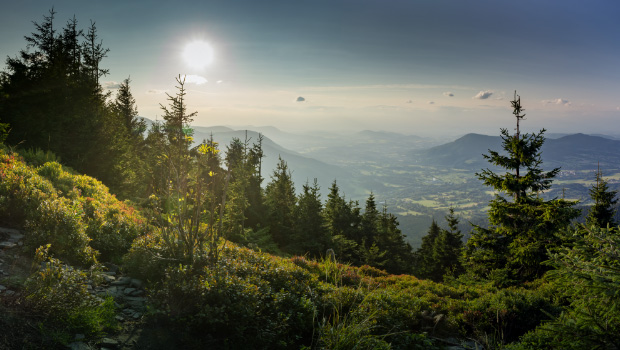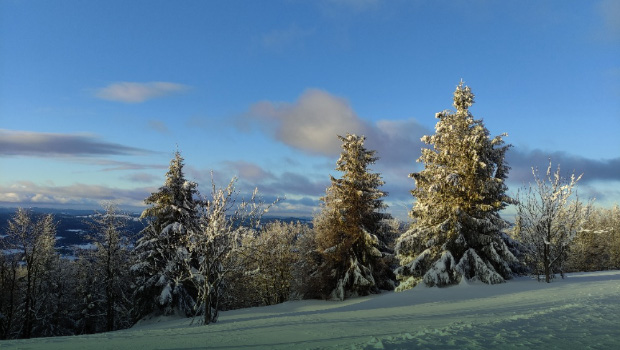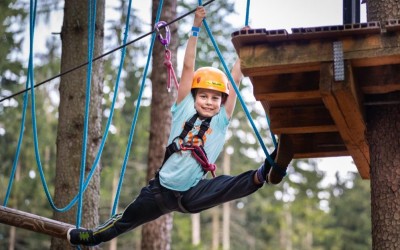
Tarzanie – a mountain rope park
Beginning at the Trojanovice Ráztoka car park, there are seven obstacles to overcome with the help of the ropes hanging between trees at heights of 4-12 m above ground. The obstacles are alternately arranged into a combination of technical and entertaining tasks of varying difficulty. No special physical strength is needed to overcome the obstacles. The safety of rope park users is assured with securing ropes, ties and helmets. Tarzanie is designed for the general public, individuals, groups, etc.
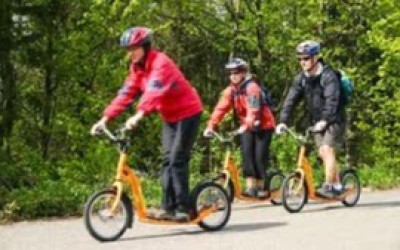
Mountain scooters
Do you like speed, are you brave and able to take risks adequate to your skill? Can you enjoy a downhill race and safely get to the bottom? You will find mountain scooters at the top cableway station. Take the cableway up the hill and then ride down via the serpentine roads with a great deal of adrenalin, as well as with beautiful vistas of the surrounding countryside (a descent by the Princely path down to the chalets).
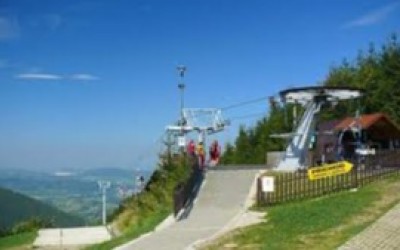
A chairlift up to Pustevny
Near the Ráztoka Hotel there is a chairlift up to the mountain village of Pustevny.
Pustevny is a significant crossroads of tourist paths – a starting point for hikes or at least a walk across the ridge to Radhošť. The Radegast educational path and the Devil's mill educational path start there. Information boards introduce tourists to the natural attractions and historic sites of the Radhošťská hornatina peaks and ridges. A fairy-tale path connects Valašská koliba and Radhošť.
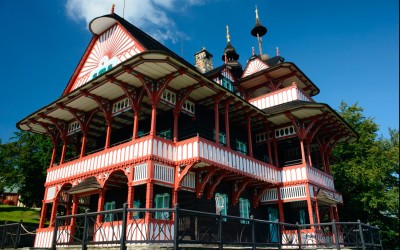
The Radegast educational path
begins at Pustevny (200 m above the Devil's mill educational path) and continues along the Radhošť ridge to the Chapel of St. Constantine and Methodius, from where it turns back to Pustevny. On the way back the route turns down along the green path after the Radegast Hotel to a horizontal path that returns along the Radhošť ridge for its last 500 m section. The educational path has 10 stops and covers an approximate distance of 9 kilometres, which is a 2-3 hour walk along a slightly undulating terrain.
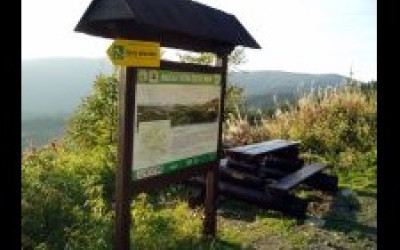
The Devil's Mill educational path
Educational path features 9 stops describing the nature and local life and institutions of the Beskydy Mountains in the surroundings of Pustevny. The path is ideal for walks or for cross-country skiing in winter. The trail is 6 km long. A predominantly naturalscience-oriented nature trail, it will introduce you to remarkable geological, botanical and zoological phenomena of the Beskydy ridge between Pustevny and Martiňák. The trail begins at Pustevny and continues along the red tourist route across the south-western slope of the Devil's Mill massif (1,206 m above sea level) to the stop near Mořské oko (Sea Eye) pond, which was created by the cleaning and deepening of the marshlands on the southern slope of the Tanečnice saddle, as performed in 1894 by members of the Radhošť Mountain Unit. The pond is used for the reproduction of rare amphibians, smooth newt, Alpine newt and Carpathian newt. The trail further continues across the Kněhyně – Devil's Mill nature reserve, described at the third stop. The next stop introduces the activities of the state-run forestry organisation Lesů ČR s.p. in favour of nature protection. The fifth stop describes the communities of flowers and beech forests. The next stop is situated on the slope below Bukovina (996 m above sea level) and offers vistas of the Rožnovská Bečva River valley and the Vsetín Hills, which can be identified using the panoramic map panel on the board. The seventh stop marks the parallel section with the green tourist route leading to the Klíny reserve, introduced by the board at the crossing. The information board at the yellow tourist route crossroad introduces Programme 2000, another activity of the state-run forestry establishment Lesů ČR s.p., . The path ends beside the former popular inn of Mr Martiňák, built 200 years ago, which was demolished in 1972 to give way to the current chalet built in its place.
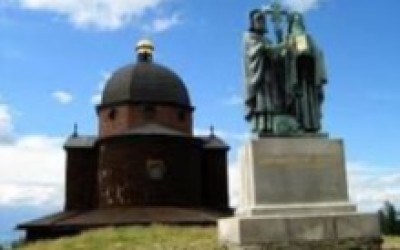
Radhošť
The mountain, rising to 1,129 metres above sea level, is often connected with the Pagan god Radegast. Before 1735, the mountain was the venue of the summer solstice ritual. Since the 1960s the mountain has been the destination point of Constantine and Methodius pilgrimages. The mountain top is adorned with two works of art. A group of statues of Constantine and Methodius (in front of the chapel bearing their names), and the statue of the Pagan god Radegast. The Radhošť peak (1,129 m above sea level) is located 4 km from the mountain saddle of Pustevny. Radhošť peak is barren and offers one of the most beautiful panoramic vistas of the Beskydy skyline, the Vsetínské vrchy hills, Javorníky, Little Fatra and the Western Tatras. The numerous rock fissures and underground caves conjure up ideas of super-natural beings. One of the most famous caves, called Volařka, is located on the slope of the ridge about 200 m south of the peak by the road to Rožnov pod Radhoštěm. This cave is 2 m wide and 3 m deep. Radhošť is a tourist attraction crossed by many different tourist paths. Radhošť is a symbolic mountain The attraction is located at the border of the Frenštát pod Radhoštěm and Trojanovice districts. The new Skies of the Beskydy education trail includes an almost 100 m long footbridge at a height of nearly 16 metres. Thus, people can explore nature amongst the treetops. The hanging structure in the Horečky locality above the Vlčák stream gorge will especially entertain families with children. The six stops will introduce the life of the birds inhabiting the surrounding trees. While the three-kilometre-long educational trail is accessible year-round, the 85-metre-long “sky walk” can only be used in the summer season.The area is interlaced with various legends and myths. See, for example, the well-known legend of the orphan of Radhošť.
Our Slavonic ancestors used this cult place for their rituals, which were aimed at winning favour of Radegast, god of harvest, herds and hospitality. In 1862, 15,000 people manifested their adherence to the rights of the nation atop Radhošť. From here, one of the cornerstones of the National Theatre was solemnly removed and transported to Prague. Since 1898, the peak bears the pilgrimage Chapel of Constantine and Methodius, with a reproduction of the painting of the Wallachian Madonna by A. Libscher, and a cross with the statues of Constantine and Methodius by A. Polášek from 1931. The statue of Radegast, the Pagan god of the Slavs, can be found about 2 km east, on the ridge, in the direction towards Pustevny. The statue is also a work by sculptor Albín Polášek. The statue was created in the United States in 1930 and transported to Frenštát pod Radhoštěm in July 1931, from where a horse and cart brought it up to Radhošť on the occasion of a Slavonic pilgrimage. The peak later became the site of a TV transformer, slightly destroying the picturesque appearance of Radhošť, but today forming an integral part of it. Accessible on foot or by mountain bike.
Walking from the Ráztoka Hotel about 100 m below the chalets
The Ráztoka Hotel is a starting pointy of a number of marked tourist trails:
- in the southern direction along the green route you can reach the peak of Radhošť and the wooden Chapel of Constantine and Methodius
- in he south-eastern direction along the blue route you can walk to the mountain settlement of Pustevny.
- If you walk in the north-eastern direction from Trojanovice along the yellow route, cross the village of Bystrá to the Na Pekliskách crossing and continue along the green route in the northern direction, you will arrive at the village of Kunčice pod Ondřejníkem.
- the village of Trojanovice is also crossed by a cycling route to Pustevny. This is also part of the route of the long-distance cycling trail known as the Beskydy-Carpathian highway.
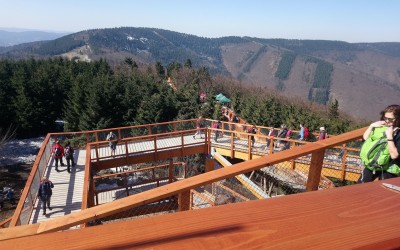
Stezka Valaška Pustevny
Nadzemní panoramatická Stezka Valaška je dlouhá 610 metrů, přičemž lesní úsek po věž je dlouhý 390 metrů a zbytek tvoří chodník na 22 metrů vysokou kaskádovitou věž. Součástí je skleněná vyhlídková plošina a 150 metrů dlouhý zavěšený "himálajský" chodník. Stezka mezi stromy stojí u horní stanice lanové dráhy na Pustevnách, hned kousek od běžeckého areálu, přibližně 250 metrů od lanovky směrem k vrcholu Tanečnica.
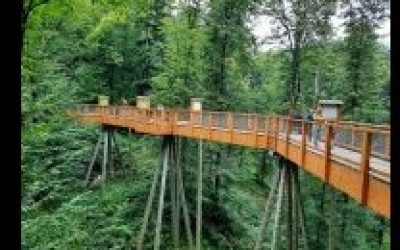
Beskydy skies
The attraction is situated on the border of the districts of Frenštát pod Radhoštěm and Trojanovice. The new Skies of the Beskydy education trail includes an almost 100 m long footbridge at a height of nearly 16 metres. Thus, people can explore nature amongst the treetops. The hanging structure in the Horečky locality above the Vlčák stream gorge will especially entertain families with children. The six stops will introduce the life of the birds inhabiting the surrounding trees. While the three-kilometre-long educational trail is accessible year-round, the 85-metre-long “sky walk” can only be used in the summer season.
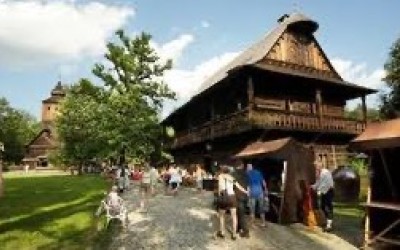
Rožnov pod Radhoštěm: A visit to the Wallachian open-air museum of folk architecture (11 km)
The extensive area of the museum is one of the most popular and best open-air museums in our country. The vast area documents the buildings, the customs and the traditions of Wallachian folk culture. The open-air museum is the venue of many periodic cultural events.
3 sightseeing tours:
Wooden town – a collection of original and reconstructed houses, according to the design by painter and graphic artist Bohumír Jaroněk. Built from 1925, the collection includes a reproduction of reeve´s house from Velké Karlovice, a reconstructed wooden church from Větřkovice, three original houses from Rožnov Square, and a reproduction of the pub from the same place. The collection is completed by a cemetery and a number of small agricultural buildings.
Mlýnská dolina – a collection of five technical structures – a mill, a sawmill, and a washboard from Velké Karlovice, an oil press from Brumov, and a copy of an iron mill from Ostravice. All structures are operable.
Wallachian village – the largest collections, currently including nearly 70 timber-framed houses that document the settlement of Wallachia with its location and equipment. Most of the houses are furnished with original equipment and are publicly accessible. The exhibition also includes a collection of sheep-keeping structures used for breeding the local Wallachian sheep.
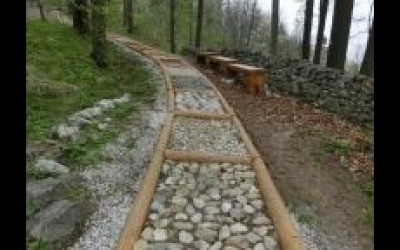
Sun Trail
At the border of Štramberk and Kopřivnice is the Sun trail with astrological symbolism and meditation places. The trail forms serpentine curves on the slope of the White Mountain of Beskydy, and its 12 stops, representing the twelve Zodiac signs, explain the astrological symbols, legends and relations. The trail also reminds of the constellations of the individual Zodiac signs. There is a word hidden at every stop – written on the bench, engraved in stone, etc. The 12 words then form a message from John Lennon.
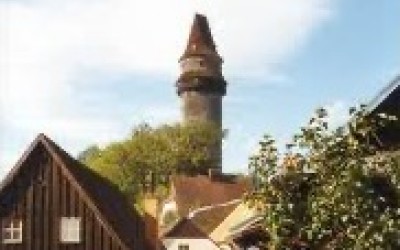
Štramberk, known as the “Moravian Bethlehem" for its picturesque appearance (17 km)
The mountain town of Štramberk, with its unique collection of preserved folk architecture, is situated close to the city of Kopřivnice in the centre of the Štrambersk highlands in the foothills of the Beskydy Mountains. Štramberk is called Moravian Bethlehem for its picturesque appearance. Štramberk itself offers a lot of travel destinations: the ruins of Trúba Castle with a 13th century observation tower, the National Orchard at Kotouč with the Šipka cave, a museum of the painter Zdeněk Burian, folk architecture of Wallachian timber houses from the 18th and 19th centuries, the museum of Novojičínsko, the White Mountain observation tower, a botanic garden and arboretum (with a continuous exposition of wetland and xerophilic vegetation). There are local species of endangered and rare plants under special protection. You can also find a stone labyrinth here, and alpinists can visit the local climbing walls in the former quarry. Other interesting sights include Aqua Terra – a mini ZOO, with a permanent exhibition of aquarium and terrarium animals with the largest freshwater aquarium in Štramberk. The exhibition is situated in the square under the stepped path to Trúba Castle. Štramberk is famous for its aromatic gingerbread product called “Štramberk ears", baked here for centuries in memory of the legendary victory of the Štramberk Christians over the Mongolian hordes on 8 May 1241. Štramberk is crossed by the Lachian educational trail. This trail, beginning and ending at the Štramberk railway station, offers several stops, the first of which is called the National Orchard. This starting point is recommended to motorised visitors, as there is a parking lot nearby. The total length of this trail is 6 km and includes 13 stops with information boards about points of interest in the locality.
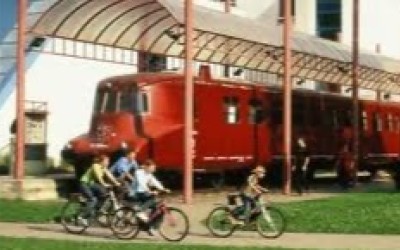
Kopřivnice (16 km)
TATRA Technical Museum: the largest collection of the Kopřivnice automotive factory and its products, later famous for its TATRA brand. Nearly sixty passenger cars and lorries from all production periods of the plant are exhibited together with chassis, engines, models, designs, trophies from competitions, period photographs and various rarities. A lot of interesting and exhaustive information is provided by multilingual video boxes with film sequences of the automotive gems.
Exhibition of Emil and Dana Zátopeks: a very modern exhibition on the premises of the Technical Museum offers, in addition to an overview of the sporting successes of the couple, a collection of authentic photographs, medals, trophies, plaques, souvenirs, Zátopek´s racing jacket and starting number from the legendary Olympic Games in London, and private items of the Zátopeks. The exhibition further includes a documentary filmed in cooperation with Finnish Television, cut to a length of 14 minutes and six seconds – the record time the greatest runner of his day needed to cover the 5-km race distance.
Lachian Museum in Šustal Villa: do not miss a permanent exhibition reminding of the local former pot-making factory, and the famous natives of Kopřivnice, including but not limited to the painter and illustrator Zdeněk Burian.
Reeve's House Museum: the museum shows the local way of life for people in the past, including their folk customs and traditions. You will also see how our ancestors travelled. It was here in 1850 that Ignace Šustala, the reeve's son, began to make his first buggies and carriages, for which he deserves mention among the famous natives of Kopřivnice.
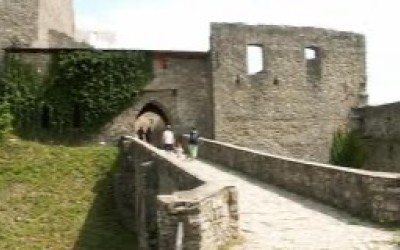
Hukvaldy Castle – the largest castle ruins in Moravia (16 km)
The large castle yard was founded around the mid-13th century and at present represents a significant cultural monument, known for its annual knights' festival and periodic weekend programmes featuring historic and folklore music and poetry. Observation lookout was built in the palace in 1993. The lookout offers unique vistas of the entire Radhošť and Moravian-Silesian Beskydy Mountain ranges, including many foothill towns in clear weather. A great attraction for all visitors is represented by the deer parkwith fallow deer and mouflon, founded by Bishop Prusinovský, which covers an area of 65 ha. The Hukvaldy name is inseparably linked to the life and work of composer Leoš Janáček. In the early 20th century he began to periodically visit the place in the summer and later bought a house here, today a Memorial of the Life and Work of Leoš Janáček. Hukvaldy inspired his operatic work, with the local atmosphere reflected in his chorus compositions set to musical poems by Petr Bezruč. The Hukvaldy Castle premises and the adjacent deer park has for several years been the host venue of the Janáček's Hukvaldy Music Festival.
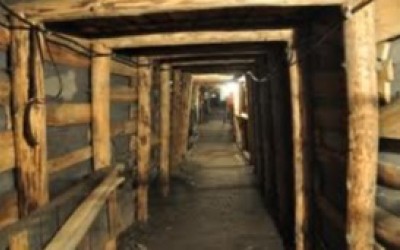
Ostrava – OKD Landek Mining Museum Landek (51 km/46 min.)
The largest mining museum in the Czech Republic with the widest range of complimentary services offers its visitors a day trip amongst monuments scattered in the natural environment. The museum is located on the south-eastern foothills of Landek Hill, overlooking the confluence of the Odra and Ostravice rivers. Landek was announced as a national natural monument in 1992. It represents a world-known locality with regard to geology, archaeology, history, natural science and mining. The connection between the mining museum as a technical monument and Landek Hill as a natural monument with its rich vegetation and wildlife lends this location its unique and attractive nature. Landek is further reknowned for its unique discovery of the Landecká Venus – a 46 mm high torso of a woman engraved in bloodstone. The slim, “cubist” shape of the Venus makes it different from typical Paleolithic Venuses. The Landek Venus is the only slim Venus in Europe. The museum was opened for the public on 4 December 1993, the day of St. Barbara, the patron saint of miners.
Exhibition:
Exhibition villa
The exposition in the exhibition villa is a suitable beginning of the tour around the area – but can also be visited as the last stop on your journey. Visitors can find broader relations between the individual exhibits seen in the other parts of the museum here, and thus multiply their impression of the visit. The building includes several separate exhibitions that together represent a cross section through the several-thousand-year history of Landek and mining in the Ostravsko region in general.
Underground exhibition – Anselm mine cultural monument
This unique exhibition is situated in the authentic historical mine of Anselm, where visitors are transported to the pit by mining cage from a historic building in the style of industrial art nouveau. Although the way down is only a few metres long, it gives the visitors an idea of how the miners got to their place of work each day.
Mine rescue exposition
The Landek exposition of mining rescue is the largest exhibition of its kind in the world. The exposition will introduce you to the highly demanding and risky activity, without which the underground work would not be possible, and the technology used by the rescuers to move around in an environment that is in some respects more hostile than the cosmic space or ocean depths.
Exhibits and exhibitions freely deployed in the area
The open-air exhibits capture the local population's activities from the Stone Age in the form of a prehistoric settlement, through the boom of mining represented by the typical industrial architecture, to the 20th century mining technology. Rather than a museum in the classical sense of the word, this exhibition is kind of combination of an indoor and an open-air museum.
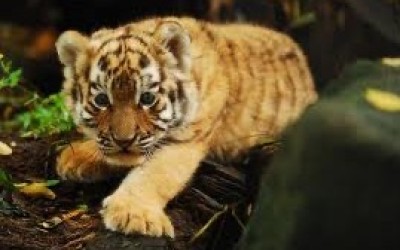
ZOO Ostrava (49 km)
The Ostrava zoological garden was established in 1951. Its area of 100 ha is home to nearly 300 animal species. African ungulates (giraffes and zebras), birds of prey and parrots, chimpanzees, lemurs, elephants, hippopotamus and many other interesting animals are in the focus of interest of all visitors. In the summer months hawker performances are shown here, while in winter you can observe the evening feeding of elephants. Weather permitting the zoo premises is even suitable for cross-country skiing in winter. Another attraction is the seasonal commented animal feeding, evening tours with a guide, or many other associated events, primarily but not only for children. There are also a couple of play corners for children on the zoo grounds. In the summer of 2007 a Botany Park was opened here, offering its visitors 2 new botany paths as a direct continuation of the zoo exhibition. A year later new enclosures were built for Rowan birds and red pandas. The zoo also offers a night animal exhibition and the first sea aquarium. In 2009 a new exhibition called “Little Amazon” was opened to show, inter alia, dwarfed monkeys and tropical species of spiders and frogs. Children will certainly appreciate the new playground with attractive play items.
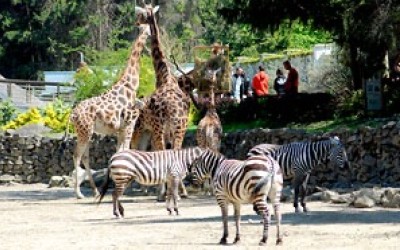
ZOO and Lešná Château park (45 km)
ZOO Zlín is the third most frequented zoological garden in the country. The zoo (52 ha) is situated in a natural area with more than 1,100 tree and decorative plant species.
The tour around the ZOO
takes 6 to 8 hours. It not only includes the exhibitions themselves, but also animal feeding and other programmes. The less demanding circuit in the upper part of the zoo can be covered in 2.5 hours. The short tour includes part of the South American exhibitions, the seal exhibition, the tropical Yucatan hall, Lipizzan horse stables, a park in the surroundings of the Lešná Château, terrariums in the château basement, the primates pavilion, an exhibition of gorillas and penguins, exotic birds and a pavilion of African ungulates.
Lešná Château
The tour around the château will take 45 minutes.
Château park and children's attractions.
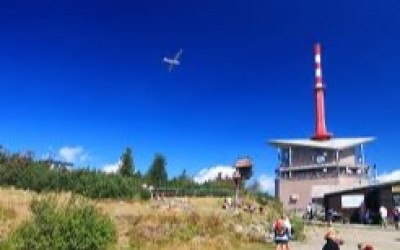
Lysá Hora mountain climb from Ostravice – a trip to the top of the highest mountain of Beskydy (1323 m above sea level)
(Medium-demand tourist trip) By car from Trojanovice via Kunčice and Čeladná to Ostravice (approx. 20 km). From the railway station at Ostravice (M) – Ostravice, Mazák – continue along the unmarked bitumen road to the Šance dam (yellow) – Pod Čuplem (yellow) – Kobylanka (yellow) – Lysá hora
Route length 10 km. The climb will take 2 hours. 20 min. The yellow tourist route uses the former educational trail around the National nature reserve of the Mazácký primeval forest with an area of 62 ha. The territory documents the natural forest growth of the fir and beech, or spruce and beech vegetation stage. The forest provides favourable habitats to many rare plants and animals. Lysá hora is sometimes called the Queen of the Moravian Silesian Beskydy Mountains. Lysá hora overlooks the unique mountain ranges and valleys of the Beskydy, the Jeseníky, and as far as the Western and High Tatras. The top of Lysá hora carries a meteorological station, a TV transmitter, the SKI mountain chalet, Šantán refreshment kiosk, the Lysá hora mountain chalet and the Kameňák hostel.
We recommend an afternoon of relaxation beside the water of the Baška reservoir or the Olešná reservoir!
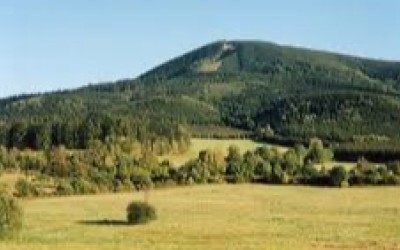
Climb from Frenštát pod Radhoštěm to the peak of Velký Javorník Mountain (918 m above sea level)
By car to Frenštát pod Radhoštěm (or on foot – circa 4 km)
Frenštát p. R. – Velký Javorník – blue route
Blue route, length 7.5 km, vertical distance 510 m. The trail starts in náměstí Míru Square and continues along Jandovo stromořadí Street, Příčnice Street in the direction to Papratná and Bartošky, and further to the saddle between the Big and the Small Javorník. From there, less than one kilometre is left to reach the peak of Big Javorník (Velký Javorník). On the way back you can also take the blue route to Padolí, where you find a mountain chalet, and further down the yellow route to the railway station at Veřovice (5 km in total). Another option is represented by the red route towards the Small Javorník (Malý Javorník, 840 m above sea level), and further along the blue route beside Kyčera (875 m above sea level) as far as the mountain saddle of Pindula, with the trendy Bandit Chalet (Zbojnická koliba) and a bus stop (5 km in total).
Frenštát p. R. – Velký Javorník – green route
Green trail, length 6 km, vertical distance 510 m. The green trail starts in the town centre and continues along the path to the Vlčina Hotel at Horečky and the forest trial to Plesová (610 m above sea level), and from there a climbing trail to the top of Velký Javorník (918 m above sea level). There you will find a mountain chalet and nice vistas of the town and the surrounding mountains, best visible in the afternoon. You can return around the ski jumps.
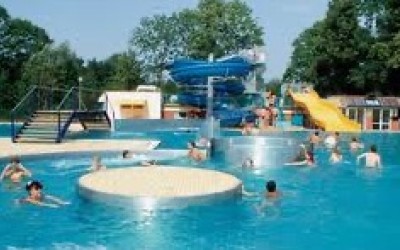
Aquapark Frenštát pod Radhoštěm (3 km)
The modern aquapark was put into operation on 7 August 2001. The aquapark is located by the main road at the exit from town in the Kopřivnice and Nový Jičín direction. Visitors can use a multi-purpose swimming pool with a depth of 0.9-1.9 m and an area of 1.049 m2. Children can use the child's pool with a depth range of 0.15-0.3 m and an area of 64 m2. The total volume of the pools amounts to 1.437 m3 of water. The greatest attraction of the park is the 60 m long and 5.8 m high toboggan run, and a water slide with a length of 13.1 metres. The entire facility with its heated water, refreshment offer, pleasant seating and volleyball courts is ideal for all generations.
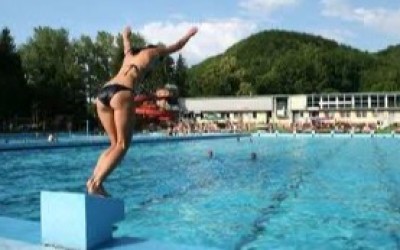
Kopřivnice (16 km)
Summer swimming pool:
the outdoor swimming pool is situated in a beautiful environment under the Red Stone massif. The area offers swimming and other water entertainment in a fifty-metre-long swimming pool, a wading pool with a water toboggan (toboggan length 70 metres), and a circular child's pool with attractions. The area further includes a beach volleyball area, a miniature golf course, table tennis equipment, a grass-covered field for football, a maxi sand pit, a sporting facility rental shop, and a restaurant with two summer bars for a pleasantly seated drink.
Indoor pool and sauna:
situated in the centre of a sporting complex on the city outskirts. A 25 metre-long swimming pool can be used for regeneration and fitness building. There is also a child's pool with a slide, a Finnish sauna, and a Greek bath. Associated services include sport and classical massages. A snack bar invites for pleasant rest.
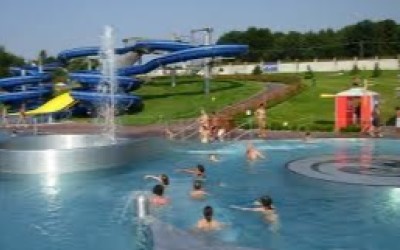
Aquapark Olešná u Frýdku Místku (20 km)
The outdoor part of the Aquapark Olešná offers swimming, relaxation and children's pools, big toboggans, smaller slides, water guns, water shots and jets, massaging nozzles, a race canal, and a climbing net. In addition to swimming and bathing, you can also hire beach volleyball or football tennis courts. The total capacity is 3.000 persons, and the water is heated to 25–28 °C. In the case of unfavourable weather, there is an indoor area at the aquapark.
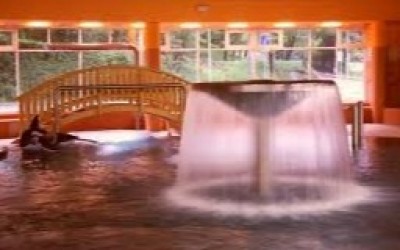
Aquapark (indoor + outdoor swimming pools) Valašské Meziříčí (25 km)
Pool operation – parameters:
- wimming pool = length 25 m, depth 1.20–1.60 m, 6 swimming lanes
- recreational pool: race canal, depth 1.20 m, swing pool, whirlpool for 8 persons, pipe massaging bed for 12 persons, massaging nozzles, pearl bath, massaging bench, water chalice, spider's web, waterfall
- children's pool = depth 0.3 m: slide, water jets, a hedgehog, a rhino, a bell
- salt whirlpool for 8 persons
- toboggan = length 92 m
- steam cabin = cooling by bucket water
- wet bar with wire transfer payment option
Wellness operation – parameters:
- salt steam chamber with star sky
- Turkish steam bath
- Finnish sauna
- herb steam bath
- infra-red cab
f) whirlpool for 6 persons with water temperature of 40 °C
The price includes: 1 sheet, 1 terry towel
Additional charged services: a terry gown
